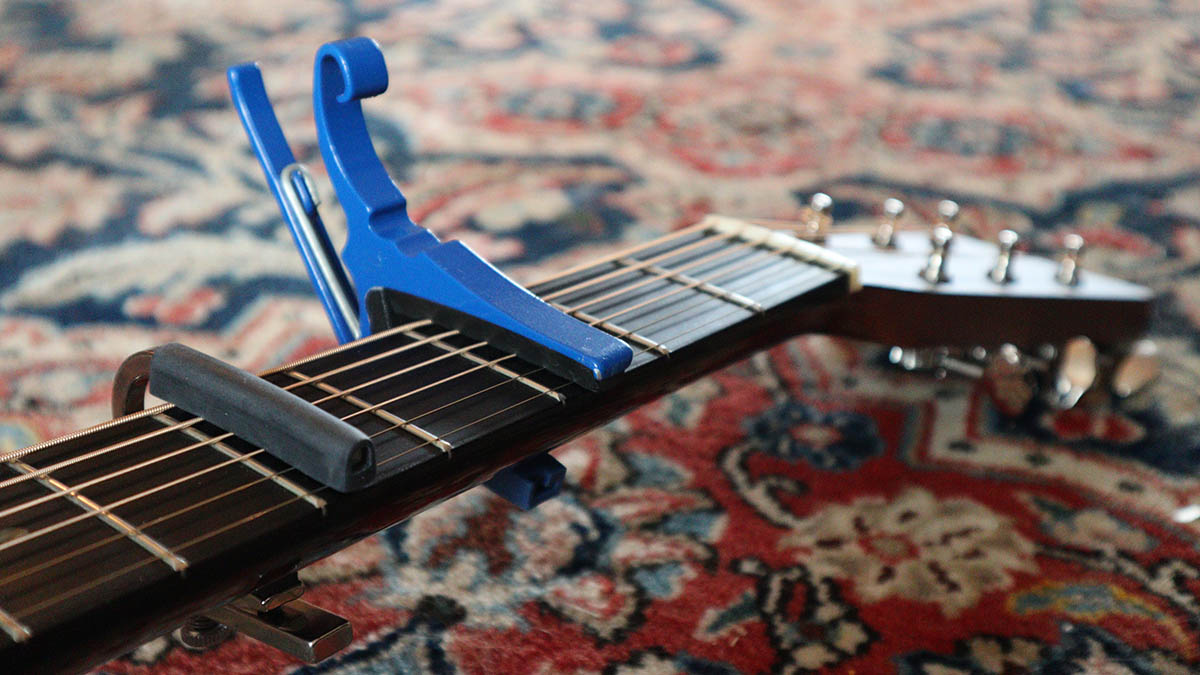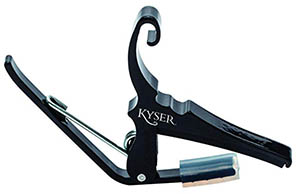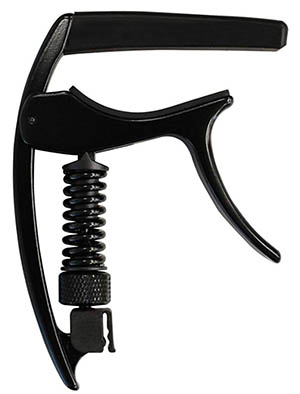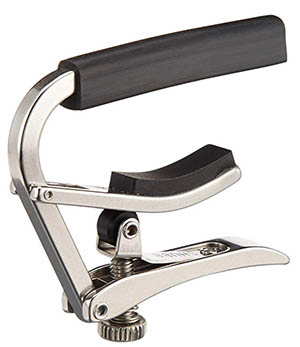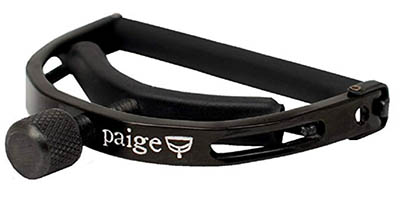A capo is the bread and butter accessory of guitar players from all genres. Much like a clip on tuner, every guitarist should have a capo or two lying around the practice room or tucked away in their guitar case.
Capos are typically used to allow open chords shapes to be played in various keys. The capo acts, in part, as a moveable nut allowing all keys to be instantly accessible, and allowing a singer to find a key that matches their vocal range.
Many different types of capos exist, and which one you’ll want to buy depends on the type of guitar you’ll be using it on. Here are our favorite capos, and the things you want to consider when buying one for yourself.
Table of Contents
Our Top Choices
The Kyser Quick Change is the most used capo of them all. Basic, no frills, and works great on almost every guitar. You can’t go wrong with one of these.
I still have the first Kyser Quick-Change Capo that I ever bought. I got it early on when I started playing guitar and it unlocked a world of songs I could play. These are great, no-nonsense capos that haven’t changed their design in decades. Because they don’t need to. It is a capo that is great for beginners or experienced guitar players on acoustic, electric, and pretty much anything in between. The Kyser is well worth the money, which thankfully is not too much.
The D’Addario Tri-Action adds a fantastic tension adjustment, making capo use above the 7th fret, and with lighter strings, more in tune.
How do you improve on a time tested design? Do exactly what D’Addario did with their quick change capo. Take the features of the Kyser Quick Change that everyone has come to love, and add the ability to adjust the tension on the clamp. This solves the problem of too strong of clamp on the strings pulling the notes sharp. This is a great quick change style capo that works with every guitar acoustic and electric.
The Shubb S1 Stainless Steel capo sports the most classy look of all the capos. With fully adjustable tension, the Shubb is great for lighter strings and acoustic guitar.
The Shubb S1 capo is another ubiquitous capo that has been used by nearly every acoustic artist since the dawn of the age. These capos are sleek, great looking capos that work on both electric and acoustic guitar. They have a fully adjustable tension which makes them perfect for use on a guitar that might have a bit thicker neck as the tension on a non-adjustable capo will increase quickly as you move up the neck.
This is not a quick-change style capo, meaning that you’ll need to use both hands when putting the capo on the guitar, and you won’t be able to store the capo on the end of the headstock (which isn’t necessarily a bad thing).
Features We Look For in the Perfect Capo
While capos are basic instruments that are meant to perform one function, there are a couple features to look at when making a purchase.
Design
This describes the basic look of the capo. Some don’t mind the look of the Kyser’s curved grip that looks like it belongs on a mandolin, or some other strange instrument from medieval times. (I’ll get a mandolin dig in whenever I get the chance). Some on the other hand like the sleek look of the Shubb that, from the viewpoint of the audience, looks only like a thick black fret.
Personally, I’m drawn to the look of the Shubb and the D’Addario capos. These have a slip profile where the trigger handle and adjustments are made behind the neck of the guitar. While the Kyser and the D’Addario are both quick change style capos, they are adjusted from opposite sides of the neck, the D’Addario from the back, and the Kyser from the front or top.
If you’re looking for classy and playing an acoustic, go with the Shubb. If you don’t mind the look of the Kyser’s handle and you don’t need it for electric guitar, then go with the Kyser.
Tension
The clamp tension is a major part of a capo, how it functions, and ultimately what instruments it can be used on. If the tension on a capo is too strong then it will have a tendency to excessively bend strings, pulling the notes sharp. There are two common scenarios where this problem can occur.
The first is with light strings either on electric guitar or acoustic. An electric guitar’s standard set of 10-46 strings for example, are too light for the tension of a Kyser capo. The capo will exert too much force on the strings and pull them all sharp. You’ll be putting on the capo and then retuning the guitar for every capo change. This is a huge pain, and impractical especially in live situations.
While the standard set of light acoustic strings from 12-53 are ok, any lighter and you’ll start experiencing the same problem as the electric guitar strings. Notes pulling sharp, too much tuning. [too much tuna image with tuning over top]
The second scenario is a thicker guitar neck that opens the capo wider than it normally goes. The wider the capo opens, the greater the tension the spring generates. On guitars with slimmer necks, this isn’t an issue, but on some guitars like the Martin D-18V I tested these capos on, the neck starts to get pretty thick above the seventh fret. This causes some tuning issues with the Kyser that can be adjusted out with the Shubb or D’Addario.
The ability to adjust clamp tension makes the D’Addario and Shubb incredibly versatile and great for use with electrics and acoustics running all gauges of strings.
Size
Like with clip on tuners, overall bulkiness makes a big difference when choosing the right capo for your playing. The Shubb provides the lowest level of bulk out of these three capos. And while both the D’Addario and the Kyser have handles that stick out, they stick out in different directions which may have an effect on your playing.
Most players won’t have this issue, but there are certain styles where playing behind the capo is necessary. Again, this doesn’t happen often but in these cases the handle pointing out, as in the Kyser configuration, will make a big difference in your ability to move around the capo.
As with the design, I prefer the sleek design of the Shubb to the Kyser. I’ve elected to use the Shubb in live scenarios where I’ll use the Kyser as my home studio capo. I like the professional look and feel of the Shubb and D’Addario capos the best.
Radius
Do you need to match the radius of the capo to the radius of the guitar neck? Yes and no. Most capos will cover a range of different neck radius ensuring use on all guitars. Most acoustic guitars are in the 12” to 16” range for neck radius, and all three capos reviewed here can handle those with no problem.
If you’re using an electric guitar, you may find that the outside strings are receiving less clamping pressure because of the flatter slope of the capo.
Below is my trusty old Kyser capo placed on the 5th fret on a variety of guitars with different neck radii all the way from 7 1/4″ to 16″. As you can see, the Kyser fits the Martin’s 16″ radius the best.
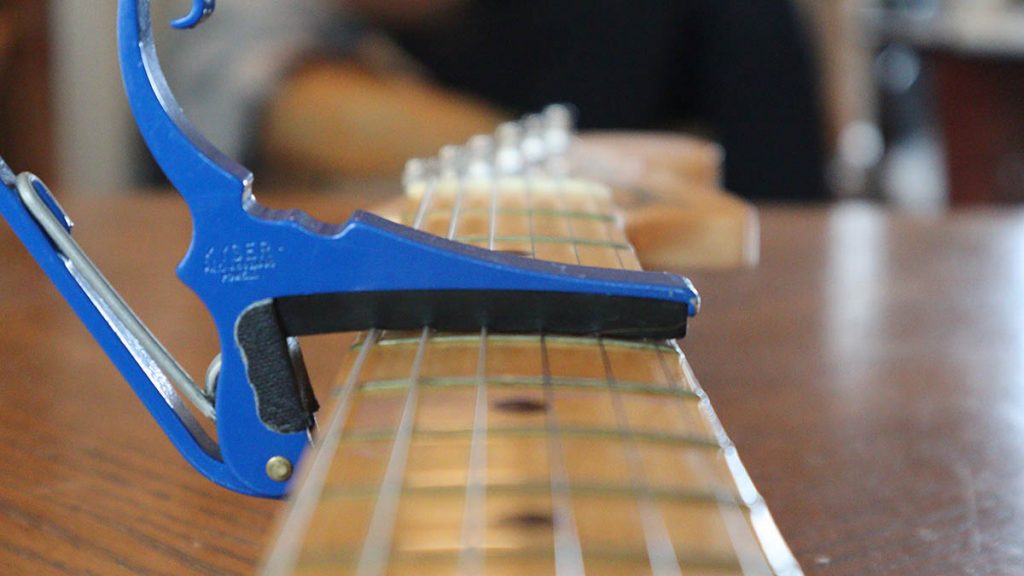
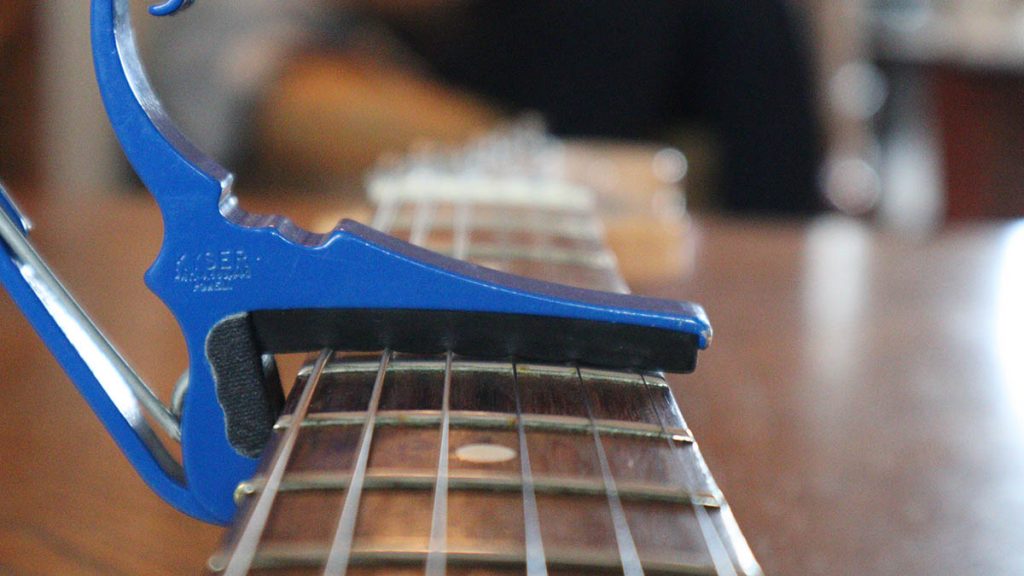
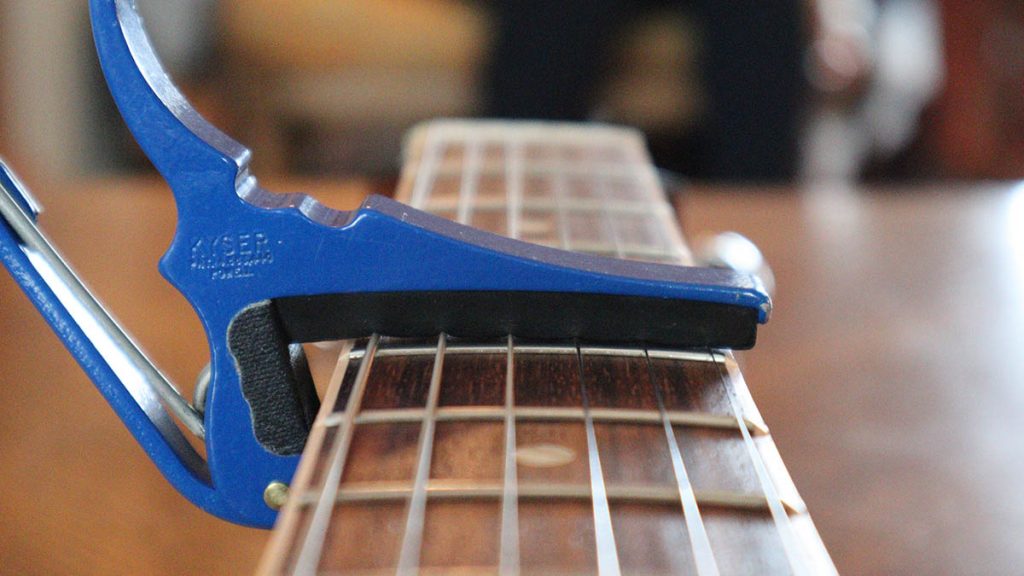
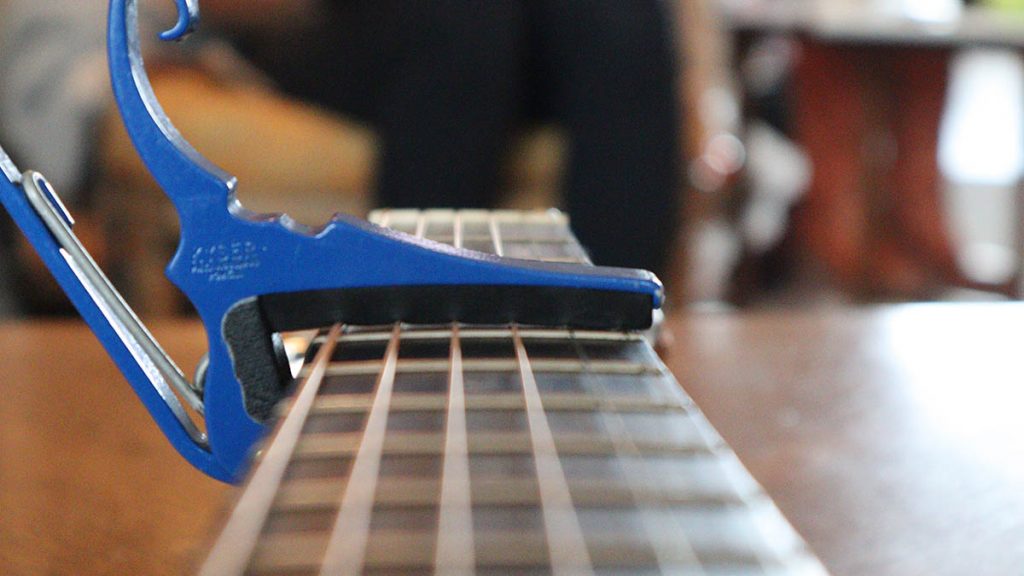
If you’re playing an acoustic guitar, don’t worry, these capos will all work just fine. If you’re using an electric just make sure that the radius isn’t super steep like the Fender vintage 7 1/4″. While the Kyser does work, the outside strings are receiving little pressure while the inside ones are getting the brunt of the squeeze. This will cause tuning problems, and won’t provide even tension across the guitar’s neck.
If you are playing a guitar with a 7 1/4″ neck radius, consider the Kyser Electric Guitar Capo.
Style
The Kyser and D’Addario are quick change capos, which means that they can be placed only using one hand. This is incredibly useful in live situations where you may want to make very quick capo adjustments.
There are other styles too, such as the Paige (mentioned in Honorable Mentions) that surround the neck and are placed over the nut when not in use. These are not quick, but offer a convenient way to place a capo on a guitar that other capos can’t do.
The Shubb requires two hands to place, and while that doesn’t bother me at all, and is my preferred capo for live settings, some might find this annoying.
Color
While color is a purely aesthetic feature of a guitar capo, I think it’s an important one. Along with the design and bulkiness factors, capo color is important when trying to look professional, especially in a live setting.
The Shubb capo is stainless steel with black padding. This is my personal favorite and in my opinion looks the best of all the capos. The D’Addario is second with an all black body, which looks good but is gloss black and doesn’t look quite as professional as the Shubb. The varying colors of the Kyser are the least professional in my opinion and is the reason I leave my blue Kyser at home while I play live. They do sell capos in black however, which is a great choice.
In Depth Review: Kyser Quick Change Capo
The Kyser is one of the most used guitar capos of all time. Watch any acoustic guitar player and they’ve probably got a Kyser somewhere close by if it’s not on the guitar or on the headstock. They’re built like a tank and won’t go bad unless you lose it. As I mentioned earlier, I still have my first capo which was a Kyser quick change. I’ve been using it for the past 20 years and it hasn’t failed me once.
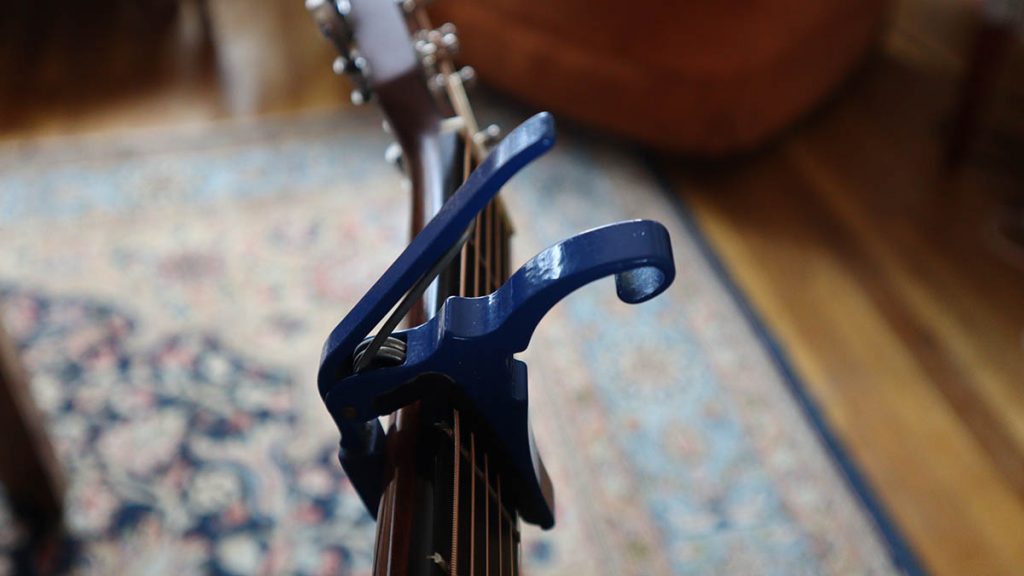
The construction is steel with quality hard rubber for the fretting portion. The bottom of the clamp which sits on the back of the guitar neck is a soft rubber which hasn’t hardened over the years, and won’t damage your guitar at all.
The Kyser is made in the USA and comes with a lifetime warranty. They’re serious about these things never breaking.
As of the writing of this review, you can get the Kyser in 23 different colors on Amazon. If you want to personalize your capo to your guitar or your favorite color. This is the capo to get. No other capo I know comes in so many different colors.
While the Kyser KG6 is the standard capo for acoustic guitar, it works on my electric guitars as well, handling the tele, strat and vintage Mustang radius without issue.
Just have a look at the reviews on Amazon, it’s clear that this is one of the best capos on the market, and you won’t regret picking up one of these.
In Depth Review: D’Addario NS Tri-Action Capo
The D’Addario Tri-Action Capo solves the issue that can crop up with the Kyser. With the ability to adjust the tension being put on the strings, the D’Addario capo can work on more guitars and more string gauges. This is a great feature that helps reduce the amount of time spent tuning, which in live situations is a godsend.
The other great feature of the NS Tri-Action is the low profile and the handle of the capo coming from the back of the guitar neck. I find this to be more ergonomically friendly and a little bit less awkward to use. This is a great design in almost every way.
There is one interesting feature of the D’Addario capo, and that is the bottom of the clamp. This portion which sits on the back of the neck is shaped rather aggressively. Compare that to the Kyser which has a flat bottom clamp arm.
The advantage of the Kyser is that it doesn’t have to be perfectly placed to still work, and I find that if you’re moving fast, it won’t always be placed perfectly. On the other hand, the D’Addario ensures (and requires) that the capo be placed correctly for the most even tension across all strings.
All in all, this is an awesome capo that will work well on all guitars, especially those with large necks or smaller gauge strings where it becomes necessary to adjust the tension.
In Depth Review: Shubb S1 Capo
The Shubb is the classiest capo on the market. It looks the best, and there is a reason why you see so many professional musicians using it. Construction wise it is made of strong stainless steel that both looks good, and ensures the capo will last as long as you haven’t lost it.
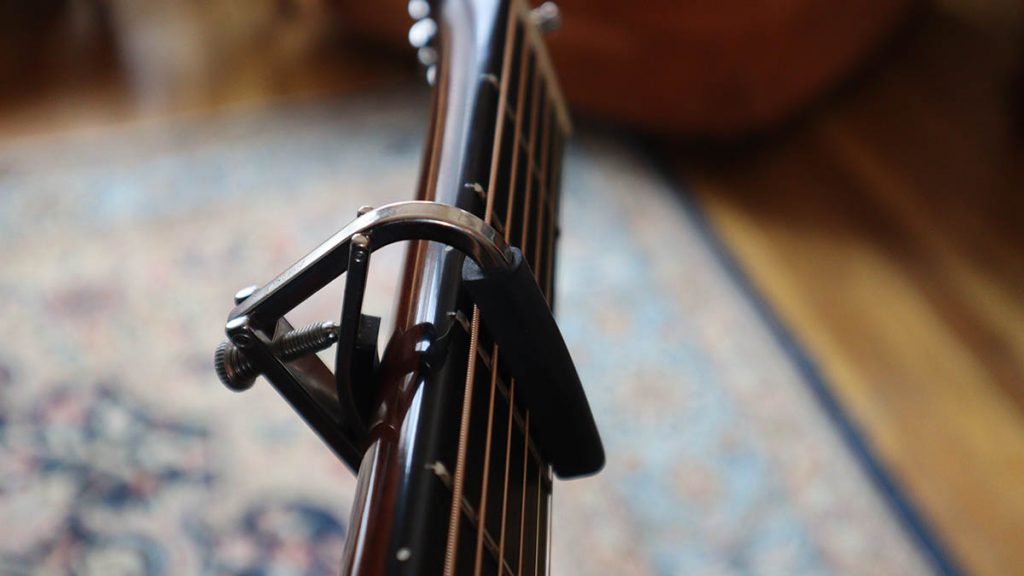
The Shubb has the smallest amount of bulk, and takes up no unnecessary space on the guitar neck. The small form factor is important because this isn’t a capo that can be clamped to the headstock when not in use. While I’d argue that you shouldn’t do that anyway, the Shubb can’t do that.
I like to stick the Shubb in my back pocket while playing live, but you can easily fit it in a front pocket as well. If you perform wearing something that doesn’t have pockets, this might be a deal breaker for this capo.
The Shubb might be my overall favorite capo of all time. I like the look and the feel most of all. It works perfectly on my Martin, and on my electrics on the rare occasion I capo my electric guitar.
Honorable Mentions
Paige Acoustic Guitar Capo
Paige Acoustic Guitar Capo, Amazon
The Paige capo is a beautiful alternative to the Kyser or Shubb style. This capo actually clips all the way around the neck of the guitar and allows you to slide the capo up and down the neck setting it in place with the tension screw on the back. When the capo isn’t in use, it can simply be slid down the neck and over the nut. Here it will sit, out of the way, while you play in standard until you need it again.
The only downside of this setup is the likelihood of unwanted buzz increases pretty drastically. It’s common for the capo’s arms to lightly touch the headstock, which can result in some buzzing sounds. This is a small complaint and overall I really enjoy these capos. Looks and bulkiness are areas in which this capo scores a perfect 10.
Bird of Paradise
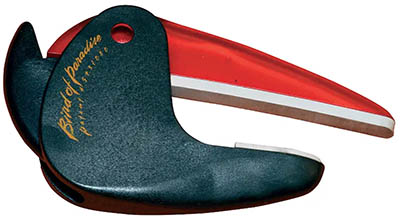
The Bird of Paradise capo is a funny capo that works for any guitar or instrument you can throw it on. The wide clamp range and the full bottom clamp makes this capo great for a wide range of neck sizes, widths, instruments and string numbers. While most 6 string capos aren’t large enough to fit on a 12 string guitar, the Bird of Paradise fits that no problem. The ability to clamp with exactly the amount of force required makes a huge difference for light strings or instruments with nylon strings.
The Bird of Paradise can be found in most studios because of their ability to work on so many different instruments.
G7 Performance 3
G7 Performance 3 Deluxe Guitar Capo, Amazon
The G7 is an incredible capo. The only reason it didn’t make the list is because it’s a little bit more expensive than most people are willing to spend for a capo. This capo is designed for one handed use and can either be placed behind the nut or on the headstock when not in use.
The really cool thing about the G7 capo is the adaptive design for multiple neck radiuses. Other capos will exert different forces on each string if the curve of the capo doesn’t perfectly match that of the neck. This is almost always the case, and especially the case if your guitar has a compound radius neck.
If your guitar does have a compound radius neck this is the best capo you can get. The G7 adapts to the different curvature and applies correct and even force across all strings.
Conclusion
You can’t go wrong with having a Kyser or two around the house. They are the overall winner as far as capos go. If you are playing an acoustic with lighter strings or if the neck of your guitar is a bit fatter, go with something that can be adjusted like the D’Addario NS Tri-Action or the Shubb S1.
If you’re like me and you are particular about how your capos look, go with the Shubb. It is by far the best looking capo on the market.
Any of these three are great capos, and will work great for almost any guitar or type of music.
What are Partial Capos?
Partial capos like the Kyser KG3B are meant to only capo certain strings allowing the other strings to ring cleanly. These capos are interesting because they provide a way to change the tuning in the open position but not in fretted positions.
Consider this, flipping the Kyser 6 string capo around and clamping strings 1-5 at the 2nd fret, leaving the low e to ring out creates an interesting tuning. It sounds like the guitar is tuned to drop d, however if you play a G shape chord it sounds like a normal G. The low E hasn’t actually changed tension so fretting any of the notes on that string will sound normal. The guitar isn’t in drop D, but it sounds like it when the low string is played open.
Using partial capos can open a massive number of opportunities for creative sounds and tunings. Check out Trace Bundy’s song Hot Capo Stew for a very creative and ridiculous number of capos used at once.
Commonly Asked Questions About Capos
How to use a capo?
Capos are easy to use. Simply clamp them on the desired fret close, but not too close to the fret ahead of it.
Too far from the fret and you’ll most likely have to deal with fret buzz. Too close to the fret and the downward tension on string will increase, causing the string to be pulled sharp.
Speaking of notes pulling sharp, it’s a good idea to check your tuning after you put a capo on your guitar to make sure that the capo isn’t pulling your instrument out of tune. You don’t have to do this every time, but you can be sure I know how much tension is required from my capo and if I’m ever recording I’ll tune multiple times before a take.
But why and when do you use a capo? A capo retains the tension of the strings, but essentially shortens the neck of the guitar. This allows you to modulate, or increase the key you’re playing in without changing the tuning of the guitar strings or changing the chord shapes that you’re using.
For example, if you’re playing a song in G with the open chords Am, D and G. Then put a capo on the 2nd fret, and play all of the same chord shapes as you did before. Now you’re in the key of A and those chords are Bm, E, A. The chord shapes didn’t change, but you moved your key up a whole step.
This is a great solution for singers as a capo allows you to find a key that matches your range without the difficult work of transposing chords into another key. Try this: if a song is too high for your vocal range, move the capo up about five frets and then sing the tune in the lower octave range than you were before. Play around with different capo placements, continuing to use the same chords as before, until you find a key that is comfortable to sing along with.
It’s as easy as that, now you know how to use a capo to find the most comfortable singing range for your voice.
Are capos for beginners?
Because capos allow you to transpose, or change, keys and keep playing the same chords as before, the only skill capos require is that you know how to play open chords. Once you have open chords down, there are few things better for your guitar progression than learning new songs.
Learning the new song is going well, but if you can’t sing along to that song because the vocal range is outside of your own, that can be frustrating. A capo is the solution. Using the steps noted above, you can adjust the capo so that you’re playing in a key that is more favorable to your vocal range.
In short, yes capos are for beginners. As long as you can play open chords, a capo will help you be able to learn more songs and sing in more keys.
Are capos for wimps / considered cheating?
Capos should not, for any reason, be considered cheating. Not only do professional musicians use them, but musicians across all genres. Consider Albert Collins, blues guitar legend, who played with a capo all the time. While this is rare for a blues player, he made it work with his style and has gone down in history as one of the greats.
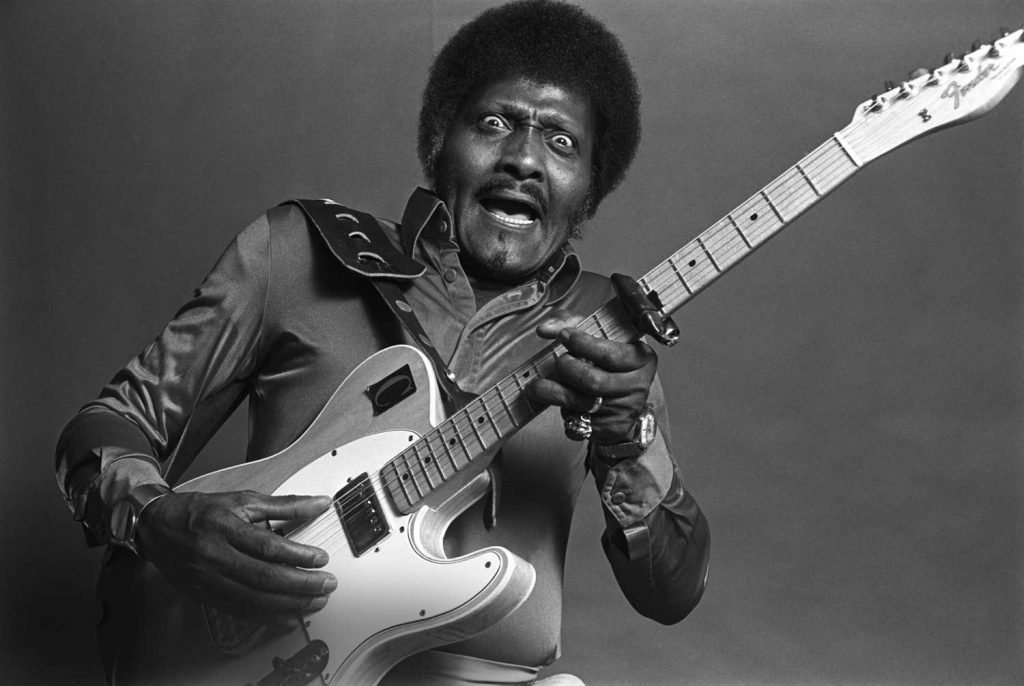
A capo isn’t a mechanism to make guitar playing easier, although that can be a helpful byproduct. It is a tool that allows us to change keys and retain the same timbre of the chord shapes that we’re using. Let me explain.
Take an open G chord. It’s loud, full, and feels resolved because of the low G and B notes on the bottom two strings. Let’s say we’re playing a simple I, IV, V which gives us the chords G, C, and D. Ok, now let’s say you wanted to transpose this song a fifth over into the key of D. Our open chords now become D, G, and A. Play that first D chord.
It just doesn’t have the same low end to it, without the low string, and if you play the 5th string you’re putting the 5th in the bass of the chord. It doesn’t sound bad, but it certainly doesn’t sound like the nice rounded fullness of the G chord in our last key.
Now, let’s use the capo. Stick it on the 7th fret and play an open G chord. You’re now playing a D, but using the “G” shape. (If you haven’t heard of the CAGED system before, now is a great time to do so.) While this new D chord your playing certainly doesn’t sound like the rich bassiness of the G chord in the open position, it has an interesting chime to it that the open D chord doesn’t have.
Playing around with these different chord shapes and keys provide some very interesting results.
Can I leave a capo clamped to the headstock?
While this is quite literally the selling point of many of the capo manufacturers, there are two good reasons why you shouldn’t leave a capo on the headstock of your guitar.
- Professionalism: I already harped on this in The Best Clip On Tuners for Guitar, and I’ll say it again here. Having something clamped to the end of the headstock while performing in live situations is not professional and looks sloppy. Go watch 10 videos of professional guitar players on YouTube. There is a good chance that while you might see them with capos and tuners on the headstock of their guitars while they’re in the studio, or at home, it’s incredibly unlikely that they do this in a live setting. If you’re playing live, don’t leave a capo clamped to the headstock of your guitar, it doesn’t look good.
- Possible Damage to the Finish: Depending on what kind of guitar and what kind of finish that guitar has on it, you may end up doing damage to the guitar if the capo is on the guitar long enough. If you do put your capo on the end of the headstock in the short term while you’re playing, make sure to pull it off before you put your guitar away. The clamping force of the capo and the rubber of the clamp arms could discolor the finish of the guitar, just like a clip on tuner can.
Leave the capo off the end of the guitar, you’ll be happier you got into that habit.
Will a capo damage a guitar?
During normal use a capo should not, in any way, leave marks or indentations on your guitar.
While most capos last a long time and are made of solid materials, cheaper capos can deteriorate leaving the rubber pads which clamp the guitar in bad shape. Inspect the pads of your capo to make sure that the rubber is in good shape and isn’t dried out or brittle. If the bottom pad which contacts the back of the neck is allowing metal to be exposed, there is a good chance that metal will damage the finish or imprint the wood.
Again, if the rubber pads are starting to go there is a good chance that they could leave a residue or discolor the finish of the guitar. While my Kyser has lasted over 20 years and the rubber is still good, I’ve seen cheap capos that start to go bad after a couple years.
In normal scenarios, a capo should not damage a guitar. Just double check the condition of your capo before clamping it on.
Will a guitar capo work on a ukulele?
Most guitar capos will not work for a Ukulele. The reason being twofold. First, the neck of a ukulele is so small that quite a few capos won’t even fit on it. Take the D’Addario Tri-Action capo for instance. The bottom clamp is designed for the neck radius of a guitar, the small neck of a uke simply won’t fit correctly in that capo.
Second, the clamping pressure of a guitar capo is way too much for a ukulele. If certain capos will pull light weight electric or acoustic strings sharp just imagine what they’d do to flimsy uke strings.
A Ukulele capo is designed specifically for both the small neck of a uke, and the low tension of the strings. If using a capo with a ukulele, make sure to tune it after you put the capo on. Nylon strings are finicky in general, and a capo doesn’t help to cover up those characteristics.
Can I use a capo on a classical guitar?
While most capos can be used on both acoustic and electric guitar, classical guitars have both a flat radius fretboard and a wide neck that disqualifies most capos from working. There are some exceptions like the Bird of Paradise which can tackle basically any instrument you throw at it. However, if you’re playing a classical guitar you’ll want to pick up a classical specific capo.
I recommend a capo that allows you to adjust the tension of the springs, like the Shubb C2 classical guitar capo. Because nylon strings don’t have nearly the tension that acoustic or electric strings do, a normal capo has too much tension on the clamp which will pull all of the strings sharp if used on a classical guitar.
The adjustable feature of the Shubb lets you dial in exactly the right amount of pressure to get a clear tone while ensuring there’s no fret buzz or sharp notes.
Can I use a capo on an electric guitar?
In most scenarios you can use a capo on an electric guitar without issue. However, some guitars have steeper neck radiuses which will cause the capo to not have enough clamping power on the outer strings. Sometimes you can shift the capo around a bit to get just enough pressure on the high e string which allows for a little more pressure for the low E.
This can be frustrating though. If you have a vintage guitar, or one that you know has a 7 ¼” radius then look for an electric specific capo which will cover these needs.
The other consideration when using a capo on an electric guitar is the difference in string tension. Electric guitar strings have less tension than acoustic strings. Therefore if you’re using a capo designed for an acoustic guitar on an electric then the tension might be a bit too high. This is the reason that I like the Shubb and Tri-Action capos. They allow you to change the tension and deal with this problem whereas capos like the Kyser don’t have this adjustment.
Again, if you need some inspiration or justification for using a capo on an electric guitar, just take a look at Albert Collins, who rocked a capo and played some incredible blues.
How do you pronounce capo?
If you’re in the US or North America, pronounce it KAY-POE. Other parts of the world that are more heavily influenced by English accents usually pronounce it CAP-POE. I’m not saying anyone is particularly wrong, but I’m not going to switch from KAYPOE any time soon.
Do capos wear out?
A good quality capo has a very long lifespan and may be warrantied for life from the manufacturer. For an example, the Kyser capo that I’ve had is still going strong after over 20 years of use. You’ll most likely lose it before it goes bad.
However, a capo could wear out in a couple places and it’s important to keep an eye out for potential spots that could actually cause damage to your guitar. First are the pads. The rubber that touches the back of the neck is generally softer and should remain supple without getting gummy or starting to break down. If the rubber is breaking down it’s time to throw the capo out and get a new one, gummy rubber can damage a guitar’s finish and in the very least make a mess that’s hard to clean.
The top piece of rubber, that actually holds the strings down, is typically a harder piece of rubber that is meant to withstand the pressure of guitar strings. While these don’t often go bad, cheaper capos will start to dry out and the rubber will become brittle.
Lastly is the spring and pivot points. Most capos are built from steel of some type and don’t have any issues with these high wear points. If your capo is wearing out abnormally contact the company, and they’ll most likely send you a new one.
